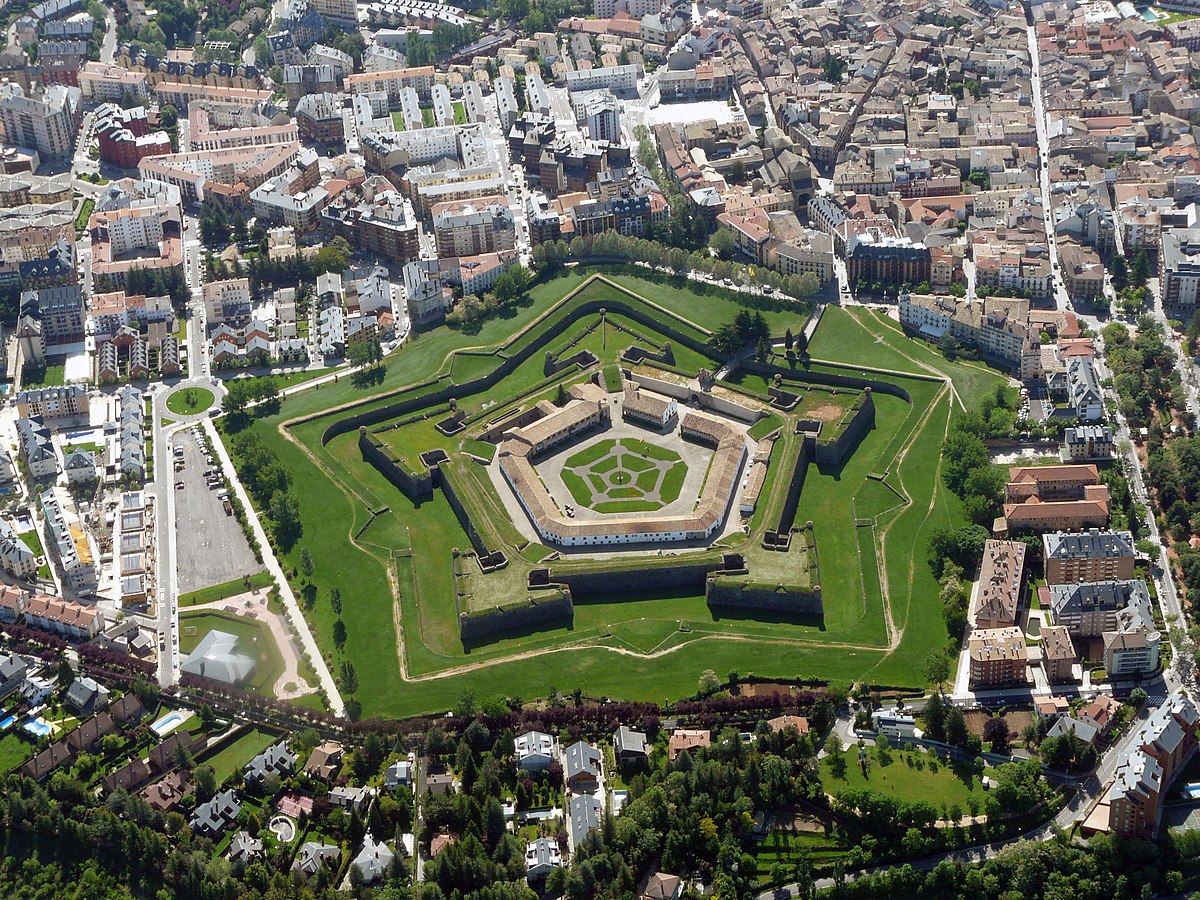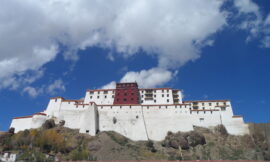A bastion is a key element of fortification design that emerged in the Renaissance period, significantly enhancing the defensive capabilities of castles and fortresses. Its primary function was to allow defenders to cover adjacent walls (curtain walls) with flanking fire, effectively eliminating blind spots and creating a more impregnable defensive system. Bastions are distinguished by their angular shape, which projects outward from the main defensive walls, providing multiple angles for firing on attacking forces.
Image: Citadel of Jaca [es], Spain, an example of a bastion fort
Design and Structure
Basic Components:
- Face: The two longer sides of the bastion, which project outward from the fortress wall.
- Flank: The two shorter sides, connecting the face to the main walls. The flanks are crucial as they allow defenders to fire along the curtain walls.
- Gorge: The inner side of the bastion, facing into the fortification. It is usually open or partially enclosed.
- Orillon: Some bastions feature rounded or recessed sections at the flanks to provide additional cover for the guns and defenders.
Shape and Angles:
- Polygonal Design: Bastions are typically polygonal, often pentagonal, with the faces forming an angle that extends outward from the main walls.
- Angles of Defense: The design ensures that attackers cannot approach the walls without being exposed to defensive fire from multiple angles, particularly from the flanks.
Historical Development
Origins and Evolution:
- Italian Renaissance: The bastion design originated in Italy in the late 15th century, during the Renaissance. Italian military engineers developed this design in response to the increasing power of artillery.
- Spread Across Europe: The bastion design quickly spread across Europe, influencing fortification styles in France, the Netherlands, Spain, and eventually England. Notable engineers, such as Sébastien Le Prestre de Vauban in France, further refined and popularized the design.
Technological Advancements:
- Adaptation for Artillery: The primary impetus for the development of bastions was the need to adapt fortifications to withstand and utilize artillery effectively. Bastions allowed defenders to mount cannons in positions where they could cover the approaches to the fortress and fire on attackers from multiple angles.
- Star Forts: The concept of bastions was integral to the development of star forts, where the entire fortress layout included multiple bastions connected by curtain walls, creating a star-shaped plan that maximized defensive coverage.
Examples of Bastioned Fortifications
Berwick-upon-Tweed:
- Elizabethan Town Walls: The town walls of Berwick-upon-Tweed, built in the late 16th century, are a prime example of bastioned fortifications in England. These walls feature large bastions at strategic points, such as Brass Bastion, Windmill Bastion, and King’s Mount, providing comprehensive defensive coverage.
Fortress of Montjuïc, Barcelona:
- Spanish Example: The fortress of Montjuïc in Barcelona, Spain, built in the 17th century, features prominent bastions that illustrate the typical star fort design. The bastions allow defenders to cover the slopes leading up to the fortress effectively.
Citadel of Lille, France:
- Vauban’s Masterpiece: Designed by the renowned French military engineer Vauban, the Citadel of Lille is one of the most famous examples of a star fort with extensive bastions. Completed in the late 17th century, it showcases the peak of bastioned fortification design.
Military and Tactical Advantages
Flanking Fire:
- Eliminating Blind Spots: Bastions allow defenders to fire along the length of the curtain walls, effectively covering any blind spots that attackers might exploit. This makes it difficult for attackers to find safe positions from which to launch assaults or set up siege equipment.
- Crossfire: The angles created by bastions enable defenders to set up crossfire, where multiple bastions can target the same area. This increases the density and effectiveness of defensive fire, making any approach hazardous for attackers.
Artillery Platforms:
- Mounting Cannons: Bastions are designed to support artillery pieces, providing stable platforms from which defenders can fire cannons. The elevated positions of the bastions allow for better targeting of attacking forces and their siege equipment.
- Enhanced Range: The projecting shape of the bastions gives artillery a broader range of fire, allowing defenders to target attackers from further away and from multiple angles.
Modern Relevance and Preservation
Heritage Sites:
- Tourist Attractions: Many bastioned fortifications have been preserved as heritage sites and tourist attractions. They offer valuable insights into historical military engineering and architecture.
- Educational Value: These sites serve as educational resources, illustrating the evolution of military tactics and fortification design in response to technological advancements.
Conservation Efforts:
- Maintenance and Restoration: Efforts to maintain and restore bastioned fortifications are essential for preserving their historical and architectural significance. This includes repairing damaged structures, preventing further deterioration, and providing interpretive materials for visitors.
Conclusion
Bastions represent a significant innovation in the history of military architecture, reflecting the adaptation of fortifications to the advent of artillery warfare. Their angular design and strategic placement provided effective defensive capabilities, allowing defenders to cover all approaches and mount powerful artillery. The Elizabethan Town Walls of Berwick-upon-Tweed, among other examples, illustrate the enduring legacy of bastioned fortifications. Today, these structures are valued not only for their historical importance but also for their architectural beauty and educational potential.



